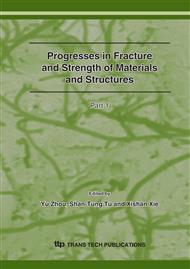p.949
p.953
p.957
p.961
p.965
p.969
p.973
p.977
p.981
Atomistic Finite Element Simulations on the Tensile Properties of Polyhedral Oligomeric Silsesquioxane (POSS) Reinforced Polystyrene
Abstract:
The influences of the polyhedral oligomeric silsesquioxane (POSS) on the mechanical properties of the polystyrene (PS) under tensile strain loading were studied using the atomistic finite element simulations. Firstly, the nano scale pole-like atomistic models and the micro scale pole-like finite element models of two kinds of homopolymers, the pure PS and the polystyrene attached with 5 mol% propyl-POSS (P-POSS-PS), were built, after which the atomistic finite element models were built by connecting the carbon and silicon atoms on the boundaries of the atomistic models to the corresponding nodes in the finite element ones. Then the mechanical behaviors of the two kinds of homopolymers under different tensile strains were investigated. The results show that, when the tensile strain of PS reaches 0.05 the micro voids appear. The tensile stresses of PS approximatively keep increasing with the increasing strain before the tensile strain of 0.07, after which the stresses declines. And the corresponding tensile modulus of PS is 4.52GPa. By contrast with PS, when the tensile strain of P-POSS-PS reaches 0.06 the micro voids appear. The tensile stresses of P-POSS-PS are almost keeping increasing before the tensile strain of 0.08, and the corresponding tensile modulus is 5.32GPa. Conclusions can be made from this work that the tensile strength of homopolymers can be observably improved by POSS. A small quantity of POSS can even improve the toughness of homopolymers slightly. This work has realistic theoretical significance to understand the reinforcement mechanism of POSS and provides important referential message to the applications of POSS.
Info:
Periodical:
Pages:
965-968
Citation:
Online since:
September 2007
Authors:
Price:
Сopyright:
© 2007 Trans Tech Publications Ltd. All Rights Reserved
Share:
Citation:


